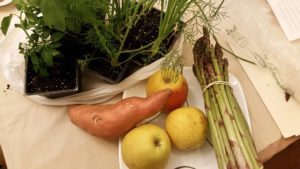 The Farmers’ Market season has begun! Some, like Burke are open now, and I got asparagus, apples, sweet potatoes and a bunch of plants.
The Farmers’ Market season has begun! Some, like Burke are open now, and I got asparagus, apples, sweet potatoes and a bunch of plants.
I love gardening, and also buying from local farmers when possible. It was a rude awakening, moving from sunny California for grad school to Northern Virginia almost 18 years ago….there were farm stands everywhere, and I was totally accustomed to easy access to fresh, beautiful food. So I’ve been gardening since to fill some of the blanks.
Since we’ve moved to a more wooded area a few years ago, my garden has largely been a buffet for the deer and groundhogs. Sometimes I get a nice harvest; other times, I’m feeding the wildlife. So far, I’ve got kale, garlic, onions, herbs, strawberries, and green beans and I  just put in potatoes, sweet potatoes, Thai peppers, basil and stevia, and more to come this weekend. I’ll put them in soon anyway and hope for the best. We also have a blackberry and blueberry plant, and even grapevines. The blackberry has a ton of flowers this year (right), which hopefully means there’s lots of fruit coming my way!
just put in potatoes, sweet potatoes, Thai peppers, basil and stevia, and more to come this weekend. I’ll put them in soon anyway and hope for the best. We also have a blackberry and blueberry plant, and even grapevines. The blackberry has a ton of flowers this year (right), which hopefully means there’s lots of fruit coming my way!
Even if the critters get my veggies, there are a bunch of Farmers’ Markets and locally grown resources to give more options, and the number of markets has only grown for the last decade. We’ve got a bunch of markets nearby, and they’re about to open or just opened.
Why go to a Farmer’s Market?
- They’re terrific for encouraging people to branch out and try new foods. There are generally a lot of samples, and everything looks so good. Works well for kids, too!
- Fresh produce and meat. Most fruits and vegetables are picked that day. Seasonal food is generally going to be more nutritionally dense than something shipped around the globe.
- Support for local farmers and the local economy.
- Few or fewer pesticides on fruits and vegetables. A plum shipped from Chile need a lot of pesticides to keep it lovely even after traveling thousands of miles.
- Greater variety. While Whole Foods or Wegmans may have 5 kinds of apples, it’s common to have a choice of 10+ varieties and discover new flavors that you enjoy.
- Better taste! There’s nothing that compares to the taste of a freshly picked tomato, peach, or apple.
- The “manufacturer” is usually right in front of you, so if you have questions about how something is made or grown, just ask!
I’d be willing to bet there’s a market near you. Here’s a listing of Farmer’s Markets
- City of Alexandria Farmer’s Markets
- Fairfax county Farmer’s Markets
- Arlington Farmer’s Market
- Listing of NoVA Markets from Northern Virginia Magazine
- Nationwide listing of USDA Farmer’s Markets
Also, another great option are CSAs (Community Supported Agriculture). If that’s more your scene, there’s a nice list here.
Whether you have a nice big garden or even just an available window, it’s a great time to get growing. Even a sunny window should work for herbs like basil.
Cheryl Harris, MPH, RD is a Registered Dietitian Nutritionist and Certified Wellcoach in Fairfax VA (and currently, remotely). She helps people with a range of dietary issues, including Celiac Disease and all sorts of GI disorders. Let’s get you on your way to achieving your goals and feeling great! Email or call 571-271-8742.




